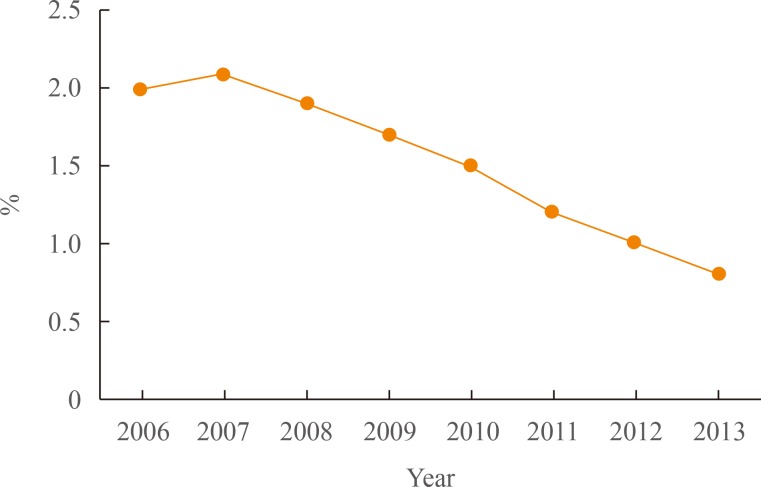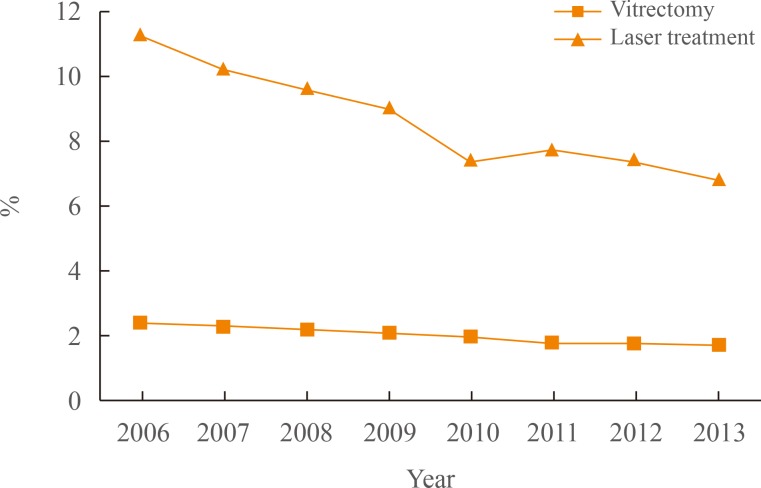Endocrinol Metab.
2016 Jun;31(2):254-257. 10.3803/EnM.2016.31.2.254.
Current Challenges in Diabetic Retinopathy: Are We Really Doing Better?
- Affiliations
-
- 1Department of Ophthalmology, Kangbuk Samsung Hospital, Sungkyunkwan University School of Medicine, Seoul, Korea. eye-su@hanmail.net
- KMID: 2308855
- DOI: http://doi.org/10.3803/EnM.2016.31.2.254
Abstract
- Management of diabetic complications has been a worldwide major global health issue for decades. Recent studies from many parts of the world indicate improvement in this area. However, it is unknown if such an improvement is being realized in Koreans. Although there is limited information regarding diabetic retinopathy management among Koreans, recent epidemiologic studies have indicated improved screening rates and less frequent visual impairment among type 2 diabetics. Moreover, results achieved with new diagnostic and treatment modalities aimed to improve diabetic retinopathy management are encouraging for both physicians and patients.
Keyword
MeSH Terms
Figure
Reference
-
1. Klein R, Klein BE. Are individuals with diabetes seeing better?: a long-term epidemiological perspective. Diabetes. 2010; 59:1853–1860. PMID: 20668290.2. Centers for Disease Control and Prevention (CDC). Self-reported visual impairment among persons with diagnosed diabetes: United States, 1997-2010. MMWR Morb Mortal Wkly Rep. 2011; 60:1549–1553. PMID: 22089967.3. Klein R, Knudtson MD, Lee KE, Gangnon R, Klein BE. The Wisconsin Epidemiologic Study of Diabetic Retinopathy: XXII the twenty-five-year progression of retinopathy in persons with type 1 diabetes. Ophthalmology. 2008; 115:1859–1868. PMID: 19068374.4. Hovind P, Tarnow L, Rossing K, Rossing P, Eising S, Larsen N, et al. Decreasing incidence of severe diabetic microangiopathy in type 1 diabetes. Diabetes Care. 2003; 26:1258–1264. PMID: 12663607.
Article5. Lin JC, Shau WY, Lai MS. Sex- and age-specific prevalence and incidence rates of sight-threatening diabetic retinopathy in Taiwan. JAMA Ophthalmol. 2014; 132:922–928. PMID: 24809869.
Article6. Keeffe J, Taylor HR, Fotis K, Pesudovs K, Flaxman SR, Jonas JB, et al. Prevalence and causes of vision loss in Southeast Asia and Oceania: 1990-2010. Br J Ophthalmol. 2014; 98:586–591. PMID: 24407561.
Article7. Resnikoff S, Pascolini D, Etya'ale D, Kocur I, Pararajasegaram R, Pokharel GP, et al. Global data on visual impairment in the year 2002. Bull World Health Organ. 2004; 82:844–851. PMID: 15640920.8. Yoon KC, Mun GH, Kim SD, Kim SH, Kim CY, Park KH, et al. Prevalence of eye diseases in South Korea: data from the Korea National Health and Nutrition Examination Survey 2008-2009. Korean J Ophthalmol. 2011; 25:421–433. PMID: 22131780.
Article9. Korean Diabetes Association. Health Insurance Review & Assessment Service. Report of task force team for basic statistical study of Korean diabetes mellitus: diabetes in Korea 2007. Seoul: Goldfishery;2008.10. Kim HK, Kim CH, Kim SW, Park JY, Hong SK, Yoon YH, et al. Development and progression of diabetic retinopathy in Koreans with NIDDM. Diabetes Care. 1998; 21:134–138. PMID: 9538984.
Article11. Kim YJ, Kim JG, Lee JY, Lee KS, Joe SG, Park JY, et al. Development and progression of diabetic retinopathy and associated risk factors in Korean patients with type 2 diabetes: the experience of a tertiary center. J Korean Med Sci. 2014; 29:1699–1705. PMID: 25469073.
Article12. Korean Diabetes Association. Health Insurance Review & Assessment Service. Report of task force team for Korean diabetes fact sheet 2015. Seoul: Goldfishery;2015.13. Sloan FA, Yashkin AP, Chen Y. Gaps in receipt of regular eye examinations among medicare beneficiaries diagnosed with diabetes or chronic eye diseases. Ophthalmology. 2014; 121:2452–2460. PMID: 25208856.
Article14. Wang D, Ding X, He M, Yan L, Kuang J, Geng Q, et al. Use of eye care services among diabetic patients in urban and rural China. Ophthalmology. 2010; 117:1755–1762. PMID: 20471689.
Article15. Bressler NM, Varma R, Doan QV, Gleeson M, Danese M, Bower JK, et al. Underuse of the health care system by persons with diabetes mellitus and diabetic macular edema in the United States. JAMA Ophthalmol. 2014; 132:168–173. PMID: 24357541.
Article16. Song SJ, Wong TY. Current concepts in diabetic retinopathy. Diabetes Metab J. 2014; 38:416–425. PMID: 25541604.
Article17. Heier JS, Bressler NM, Avery RL, Bakri SJ, Boyer DS, Brown DM, et al. Comparison of aflibercept, bevacizumab, and ranibizumab for treatment of diabetic macular edema: extrapolation of data to clinical practice. JAMA Ophthalmol. 2016; 134:95–99. PMID: 26512939.18. Bressler SB, Glassman AR, Almukhtar T, Bressler NM, Ferris FL, Googe JM Jr, et al. Five-year outcomes of ranibizumab with prompt or deferred laser versus laser or triamcinolone plus deferred ranibizumab for diabetic macular edema. Am J Ophthalmol. 2016; 164:57–68. PMID: 26802783.
Article19. Brown DM, Nguyen QD, Marcus DM, Boyer DS, Patel S, Feiner L, et al. Long-term outcomes of ranibizumab therapy for diabetic macular edema: the 36-month results from two phase III trials: RISE and RIDE. Ophthalmology. 2013; 120:2013–2022. PMID: 23706949.20. Dubois-Dalcq M, Armstrong R. The cellular and molecular events of central nervous system remyelination. Bioessays. 1990; 12:569–576. PMID: 2080911.
Article21. Friberg TR, Pandya A, Eller AW. Non-mydriatic panoramic fundus imaging using a non-contact scanning laser-based system. Ophthalmic Surg Lasers Imaging. 2003; 34:488–497. PMID: 14620758.
Article22. Kaines A, Oliver S, Reddy S, Schwartz SD. Ultrawide angle angiography for the detection and management of diabetic retinopathy. Int Ophthalmol Clin. 2009; 49:53–59. PMID: 19349786.
Article23. Kan H, Stevens J, Heiss G, Klein R, Rose KM, London SJ. Dietary fiber intake and retinal vascular caliber in the atherosclerosis risk in communities study. Am J Clin Nutr. 2007; 86:1626–1632. PMID: 18065579.
Article24. Wang L, Wong TY, Sharrett AR, Klein R, Folsom AR, Jerosch-Herold M. Relationship between retinal arteriolar narrowing and myocardial perfusion: multi-ethnic study of atherosclerosis. Hypertension. 2008; 51:119–126. PMID: 17998474.25. Cheung N, Islam FM, Jacobs DR Jr, Sharrett AR, Klein R, Polak JF, et al. Arterial compliance and retinal vascular caliber in cerebrovascular disease. Ann Neurol. 2007; 62:618–624. PMID: 17918248.
Article26. Lundberg K, Kawasaki R, Sjolie AK, Wong TY, Grauslund J. Localized changes in retinal vessel caliber after focal/grid laser treatment in patients with diabetic macular edema: a measure of treatment response? Retina. 2013; 33:2089–2095. PMID: 23514802.27. Nguyen TT, Wang JJ, Sharrett AR, Islam FM, Klein R, Klein BE, et al. Relationship of retinal vascular caliber with diabetes and retinopathy: the Multi-Ethnic Study of Atherosclerosis (MESA). Diabetes Care. 2008; 31:544–549. PMID: 18070990.28. Klein R, Klein BE, Moss SE, Wong TY. Retinal vessel caliber and microvascular and macrovascular disease in type 2 diabetes: XXI: the Wisconsin Epidemiologic Study of Diabetic Retinopathy. Ophthalmology. 2007; 114:1884–1892. PMID: 17540447.29. Cheung CY, Ikram MK, Klein R, Wong TY. The clinical implications of recent studies on the structure and function of the retinal microvasculature in diabetes. Diabetologia. 2015; 58:871–885. PMID: 25669631.
Article30. Mookiah MR, Acharya UR, Fujita H, Tan JH, Chua CK, Bhandary SV, et al. Application of different imaging modalities for diagnosis of diabetic macular edema: a review. Comput Biol Med. 2015; 66:295–315. PMID: 26453760.
Article31. Sim DA, Keane PA, Tufail A, Egan CA, Aiello LP, Silva PS. Automated retinal image analysis for diabetic retinopathy in telemedicine. Curr Diab Rep. 2015; 15:14. PMID: 25697773.
Article32. Aghamohamadian-Sharbaf M, Pourreza HR, Banaee T. A novel curvature-based algorithm for automatic grading of retinal blood vessel tortuosity. IEEE J Biomed Health Inform. 2016; 20:586–595. PMID: 25622332.
- Full Text Links
- Actions
-
Cited
- CITED
-
- Close
- Share
- Similar articles
-
- The Influences of Arteriosclerosis on the Development and Progression of Diabetic Retinopathy
- Clinical Review on Diabetic Retinopathy
- Changes of ERG Parameters in Diabetic Retinopathy
- Photopic Flash ERG Changes in Diabetic Retinopathy: with reference to severity of diabetic retinopathy
- The Relationship between Diabetic Retinopathy and Corneal Autofluorescence



